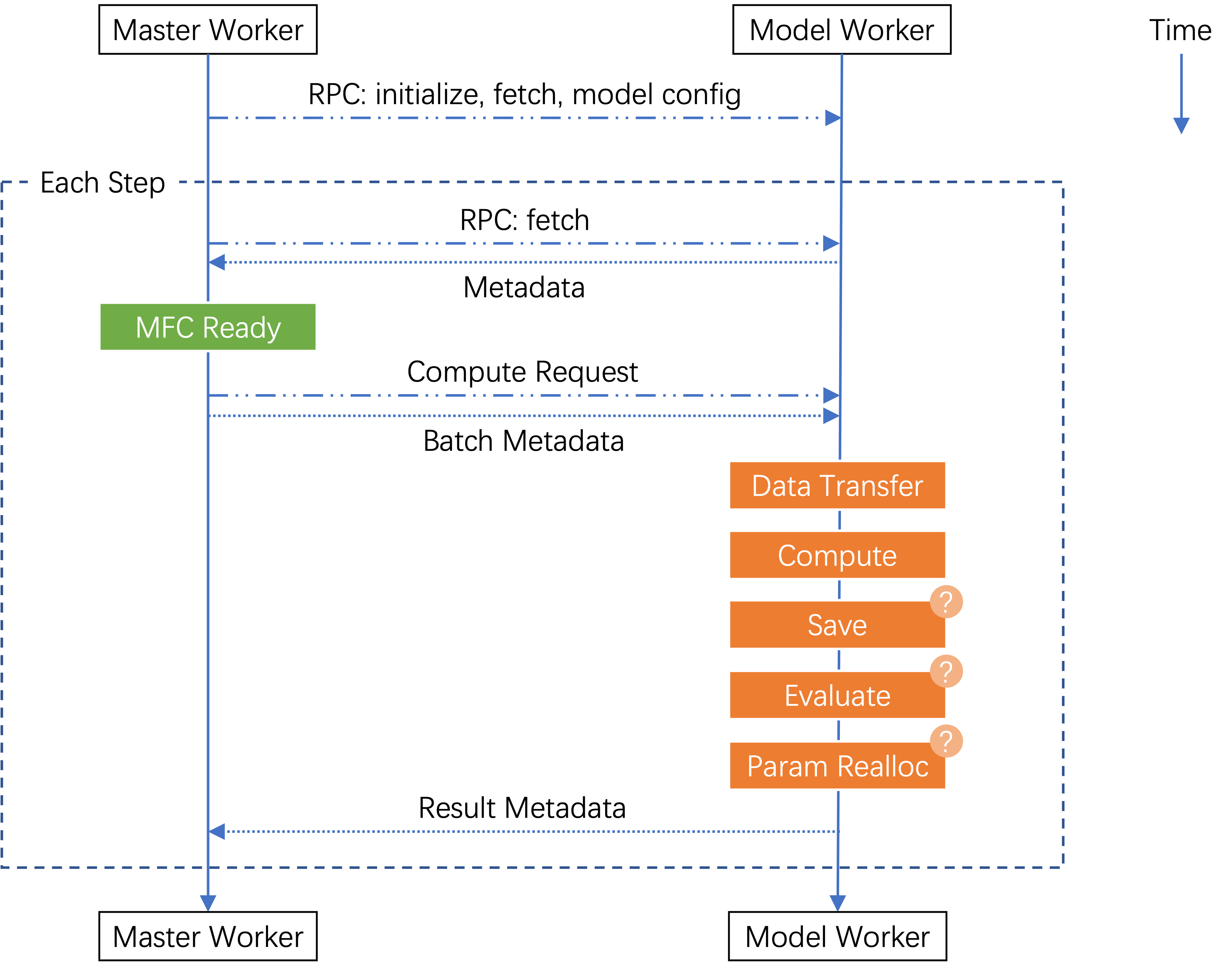Model Worker#
Master-Model Worker Interaction#
The master worker sends remote procedure calls (RPCs) to model workers to execute actual
computations like actor_train. The figure below illustrates their interaction
throughout an experiment:

Model worker “compute” involves running a model interface with a specific backend (covered in detail later). For synchronous PPO algorithms, model workers sequentially execute:
actor_gen:actormodel with SGLang backend +PPOActorInterface.generaterew_inf:rewardmodel (can be null for RLVR) +MultiTaskRewardInterface.inferenceactor_train:actormodel with Megatron backend +PPOActorInterface.train_step
Note
For asynchronous PPO, only actor_train is executed.
Communication Protocol#
Request-Reply Pattern#
The master worker and model workers communicate through a request_reply_stream channel
that handles requests and metadata responses. Actual data like input_ids transfers
through other channels.
The master (client) can send these requests to model workers (servers):
fetch: Worker loads local dataset data and sends metadata (e.g., sequence length) to master for buffer storage
spec: Worker returns dataset specifications for master to calculate experiment steps
model_config: Worker provides transformer model configuration
clear_data_cache: Worker clears data transfer and GPU caches
initialize: Worker initializes parameters, gradient buffers, and optimizer states
generate/inference/train_step: Worker executes corresponding computation (note: “inference” refers to a single forward pass)
Request Hooks#
Computation requests (“generate”/”inference”/”train_step”) support pre- and post-hooks for:
Data transfer (pre-hook)
Evaluation
Offloading
Parameter reallocation
Checkpointing (post-hooks)
These hooks often require NCCL communication and synchronization between workers. Implementing them as dedicated hooks prevents deadlocks that could occur if these operations were interleaved with other NCCL communications.
Request Types#
Blocking requests: Long-running operations requiring NCCL synchronization. Workers can’t execute immediately since concurrent blocking requests may need coordinated data transfers. The master sends a “flush” request to indicate that all concurrent requests have been sent.
Non-blocking requests: Shorter operations without NCCL requirements that can execute immediately.
Data Management#
Distributed Dataset Storage#
Datasets are distributed across model workers without overlap. For each model:
Processes with PP rank = -1 and TP rank = 0 serve as DP heads
Data is stored on DP heads of the model used in the first MFC (e.g., actor model DP heads for PPO)
During “fetch” requests:
DP head worker loads data into local buffer
Sends metadata to master
Master tracks metadata and later instructs workers which data to use for each MFC via computation request hooks
Note
For asynchronous RL, the “dataset” will be a StreamDataset instance that pulls data from the rollout worker. After data is loaded, the subsequent MFC calls follow the same procedure as described above.
Data Transfer Process#
For each MFC, the master:
Specifies which data to use
Provides data locations across workers
Workers redistribute data using:
Redistributor: Generates NCCL broadcast/gather/scatter communication planDataManager: Executes the plan
After redistribution, workers with the same DP rank receive identical input data.
MFC Output Handling#
Only workers with PP rank=-1 and TP rank=0 produce output data. These workers:
Store data locally
Notify master of data locations
Master generates new redistribution plans for subsequent MFCs based on this layout information
